Leveraging Automation for Risk Compliance in IT
Organizations often encounter the challenge of managing complex technology ecosystems while ensuring data security, compliance, and risk management. One crucial aspect of this challenge is risk compliance in IT environments, specifically Linux systems.
However, maintaining risk compliance can be simple and effective, even in complex environments, with the help of automation tools. In this blog post, we will explore the benefits of automation in ensuring risk compliance, focusing on Linux environments.
Understanding Risk Compliance in IT
Risk compliance in IT refers to the set of rules, procedures, and policies implemented to identify, assess, and minimize risks to an organization’s IT infrastructure. Compliance includes various regulatory requirements and industry standards. It ensures that an organization’s IT systems and data are secure, confidential, and available as needed.
Linux environments have become prominent in IT infrastructures due to their stability, security, and flexibility. However, like in any other IT environment, maintaining risk compliance in Linux systems requires best security practices, constant vigilance, and adherence to laws and regulations.
The Role of Automation in Risk Compliance
The introduction of automation techniques in the world of IT risk compliance has completely changed the game. Automation has several benefits that make it a compelling choice for organizations seeking to uphold the highest level of security and compliance.
Let’s look at some key benefits:
Consistency and Accuracy
Automation tools make sure that all compliance requirements are consistently met across the entire IT infrastructure. Additionally, it lowers the risk of human errors, which can be a serious concern when managing complex Linux systems. Automated processes are more dependable in accurately completing repetitive tasks, thereby reducing the likelihood of non-compliance incidents.
Rapid Threat Detection and Response
Automation enables continuous monitoring of Linux environments for potential risks and non-compliance issues. It can quickly identify violations of compliance standards, allowing organizations to respond promptly to emerging threats.
Automated Security Patching
Automated tools can be used to apply updates or patches to software or systems in order to address known vulnerabilities. This proactive approach helps organizations keep their systems up to date with the latest security updates without manual intervention, reducing the risk of exploitation by potential threats and improving overall cybersecurity posture.
TuxCare’s KernelCare Enterprise automatically applies all security patches to the Linux system without reboots or downtime, helping organizations stay secure and compliant with various regulatory patching requirements.
Streamlined Auditing and Reporting
Compliance often requires extensive documentation and reporting. Automation tools can generate detailed reports on the state of Linux systems, making it easier for auditors to assess compliance. This not only saves time but also ensures that the compliance audit is readily available when needed. Tools like Lynis and OpenSCAP help in security assessment and compliance auditing.
Leveraging Automation in Linux Environments
Continuous Monitoring
It is essential to monitor Linux environments for security and compliance issues on a regular basis. For risk compliance in IT, consider implementing automated monitoring tools like Nagios, Zabbix, or Prometheus. These tools can be configured to alert administrators when compliance issues are found.
Patch Management
Linux patching is the process of applying security updates to the Linux system to address vulnerabilities. It is crucial to apply security patches on time to keep Linux systems up to date and secure. Delaying or missing patches can have negative impacts on the security and compliance of organizations.
To avoid this, organizations can automate the patching process with KernelCare Enterprise. KernelCare is a live patching solution, which means security updates are applied without requiring a system reboot. It ensures 100% uptime of your Linux environments by eliminating any patching-related downtimes. It supports many enterprise distributions, including Ubuntu, Debian, RHEL, CentOS, CentOS Stream, AlmaLinux, Oracle Linux, and more.
Security Information and Event Management System (SIEM)
Implement SIEM solutions provides real-time analysis of security data generated by networks, applications, and systems across an organization’s IT infrastructure. SIEM solutions give organizations a comprehensive view of their cybersecurity, making it easier to identify security events, monitor suspicious activities, and respond quickly to potential threats.
Configuration Management
Automate the deployment of Linux servers using configuration management tools like Ansible, Puppet, or Chef. With the help of these solutions, organizations can specify the desired state of their systems and ensure that configurations continue to adhere to relevant rules and standards.
Final Thoughts
Utilizing automation for risk compliance in IT is a proactive approach to maintaining security and complying with regulatory requirements. Automation tools help enterprises better safeguard their Linux systems while lowering the administrative burden by guaranteeing consistency, accuracy, and scalability. As IT security continues to evolve, organizations that adopt automation will be better equipped to tackle the challenges of risk compliance, ensuring the integrity and security of their IT infrastructure.
Schedule a conversation with a Linux security expert to learn how to reduce risks and protect your organization.



 Documentation
Documentation Login
Login




